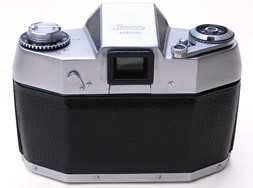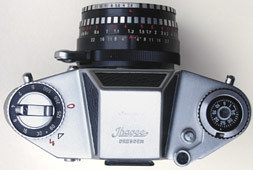Difference between revisions of "Exa 500"
m (changed all photos to cw pool) |
m (link) |
||
| Line 3: | Line 3: | ||
|image= http://farm3.static.flickr.com/2313/2345901043_7544da0a7e.jpg | |image= http://farm3.static.flickr.com/2313/2345901043_7544da0a7e.jpg | ||
|image_align= right | |image_align= right | ||
| − | |image_text= Exa 500 with 50mm/2.8 [[ | + | |image_text= Exa 500 with 50mm/2.8 Meyer [[Domiplan]] lens,<br>showing stop-down lever covering<br>shutter release and added accessory shoe |
|image_by= AWCam | |image_by= AWCam | ||
|image_rights= with permission | |image_rights= with permission | ||
Revision as of 01:56, 4 November 2012

|
| Exa 500 with 50mm/2.8 Meyer Domiplan lens, showing stop-down lever covering shutter release and added accessory shoe image by AWCam (Image rights) |
The Exa 500 - also known as the Exakta 500 and VX 200 - was introduced in 1966 by Ihagee of Dresden, Germany (then DDR/East Germany). It was the last of the Exa line of 35mm SLRs.
Description
The Exa 500 shared an unusual "bulgy" shape with other Exa SLRs. The shutter-release was a separate button, on the body to the photographer's left side of the the lens - underneath the lens-mounted stop-down lever (or button, depending on lens). Pressing the lever stopped-down the lens, and further pressure also pressed the shutter-release. This arrangement meant that there was no coupling necessary from camera to lens to stop down the diaphragm. The lens mount was the Exakta bayonet fitting.
The vertical cloth focal-plane shutter was faster than the earlier Exas, running from 1/2 - 1/500s. The speed dial is mounted around the rewind crank.
The eye-level pentaprism viewfinder was fixed, and featured an instant-return mirror and a bright ground-glass focusing screen with central microprism - all unlike many other Exas. There was a red pointer in the viewfinder to indicate when winding was required.
The advance lever has a travel of only ~120° - shorter than previous Exas. Around the top of the advance lever, the frame counter counts down; on the edge of the counter is a film speed reminder. The back of the camera features a shutter lock lever.
The back and the base of the camera was completely removable for loading film; this being released by rotating the surround of the tripod bush.

|
| Back view, showing shutter lock to left of viewfinder. image by AWCam (Image rights) |

|
| Top view, showing shutter speed dial around rewind crank. image by AWCam (Image rights) |